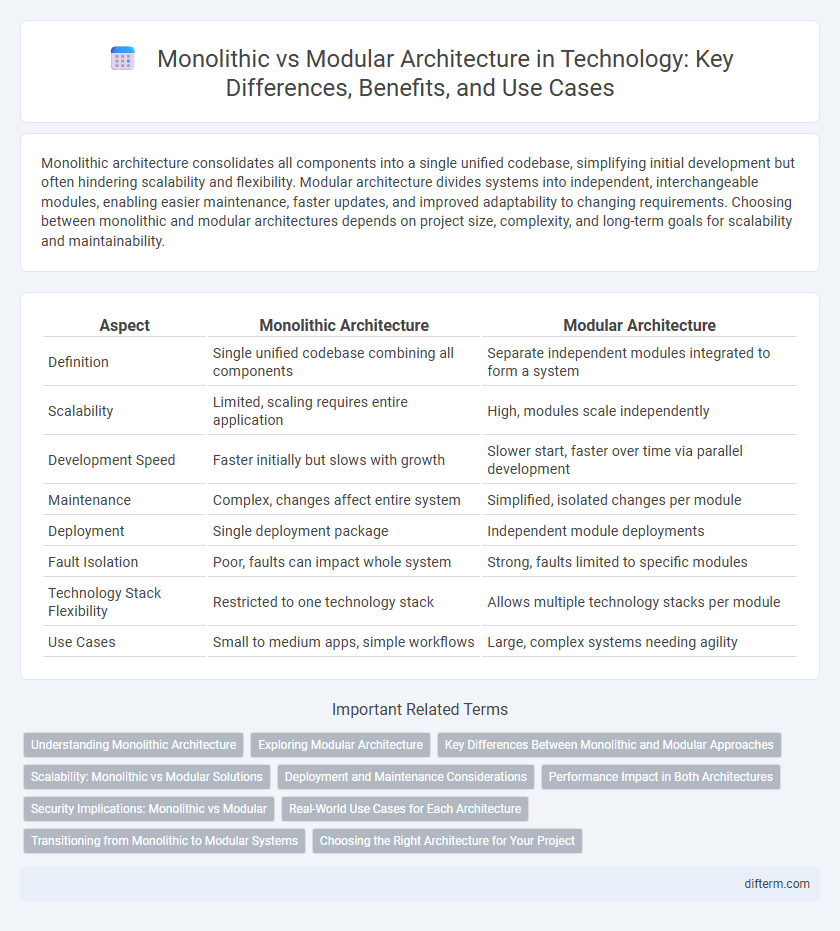Monolithic architecture consolidates all components into a single unified codebase, simplifying initial development but often hindering scalability and flexibility. Modular architecture divides systems into independent, interchangeable modules, enabling easier maintenance, faster updates, and improved adaptability to changing requirements. Choosing between monolithic and modular architectures depends on project size, complexity, and long-term goals for scalability and maintainability.
Table of Comparison
| Aspect | Monolithic Architecture | Modular Architecture |
|---|---|---|
| Definition | Single unified codebase combining all components | Separate independent modules integrated to form a system |
| Scalability | Limited, scaling requires entire application | High, modules scale independently |
| Development Speed | Faster initially but slows with growth | Slower start, faster over time via parallel development |
| Maintenance | Complex, changes affect entire system | Simplified, isolated changes per module |
| Deployment | Single deployment package | Independent module deployments |
| Fault Isolation | Poor, faults can impact whole system | Strong, faults limited to specific modules |
| Technology Stack Flexibility | Restricted to one technology stack | Allows multiple technology stacks per module |
| Use Cases | Small to medium apps, simple workflows | Large, complex systems needing agility |
Understanding Monolithic Architecture
Monolithic architecture integrates all components of a software application into a single, unified codebase, making it simpler to develop and deploy initially. This architecture often results in tight coupling between modules, which can hinder scalability and complicate maintenance as the application grows. Understanding the inherent limitations of monolithic systems is crucial for evaluating when to transition toward more flexible modular architectures.
Exploring Modular Architecture
Modular architecture divides software into independent, self-contained components that enhance scalability and maintainability, contrasting with monolithic structures that bundle functionality into a single codebase. This separation allows teams to develop, test, and deploy modules independently, accelerating release cycles and improving system resilience to failures. Emphasizing APIs and well-defined interfaces, modular architecture supports continuous integration and promotes easier adaptation to evolving technology stacks.
Key Differences Between Monolithic and Modular Approaches
Monolithic architecture consolidates all components into a single, unified system, resulting in simpler deployment but limited scalability and flexibility. Modular architecture separates functionalities into independent, interchangeable modules, enhancing maintainability, scalability, and facilitating parallel development. Key differences include deployment complexity, ease of updates, fault isolation, and resource optimization across both approaches.
Scalability: Monolithic vs Modular Solutions
Monolithic architecture often faces scalability challenges due to its tightly coupled components and single codebase, making it difficult to scale individual features independently. Modular architecture enables seamless scalability by allowing independent deployment and scaling of discrete modules, optimizing resource allocation and performance. This flexibility in modular solutions supports dynamic growth and faster adaptation to changing technological demands.
Deployment and Maintenance Considerations
Monolithic architecture centralizes all components into a single deployable unit, simplifying initial deployment but complicating updates and scaling due to tight coupling. Modular architecture separates functionality into discrete, independently deployable modules, enabling faster updates, easier maintenance, and scalable deployment strategies such as microservices. Containerization and orchestration tools like Kubernetes enhance modular deployments by automating scaling, rollback, and service discovery, reducing downtime and operational complexity.
Performance Impact in Both Architectures
Monolithic architecture often delivers faster performance due to tightly integrated components enabling direct communication and reduced latency. Modular architecture, while potentially introducing slight overhead through inter-module communication, enhances scalability and maintainability without significantly compromising performance. Optimizing interface design and efficient data exchange protocols in modular systems can mitigate performance impacts, balancing flexibility with speed.
Security Implications: Monolithic vs Modular
Monolithic architecture centralizes the codebase, creating a larger attack surface and increasing the risk of a single vulnerability compromising the entire system, whereas modular architecture isolates components, limiting potential damage and containing breaches within specific modules. Modular design facilitates granular access controls and easier security updates, reducing the likelihood of widespread security failures. Organizations adopting a modular approach benefit from enhanced threat isolation and improved resilience against targeted attacks.
Real-World Use Cases for Each Architecture
Monolithic architecture suits applications requiring tight integration and straightforward deployment, such as traditional e-commerce platforms and legacy banking systems, where performance and simplicity are critical. Modular architecture excels in large-scale, evolving environments like microservices-based cloud applications, allowing independent development and scalability, as seen in Netflix and Amazon's infrastructure. Real-world use cases highlight monolithic design for rapid initial delivery, while modular approaches enable continuous integration and flexible updates in complex systems.
Transitioning from Monolithic to Modular Systems
Transitioning from monolithic to modular architecture enhances system scalability by breaking down tightly integrated components into independent, reusable modules. Modular systems improve maintainability and accelerate development cycles through parallel workflows and easier code updates. Organizations adopting modular design benefit from increased flexibility, enabling smoother integration of new technologies and faster adaptation to changing business requirements.
Choosing the Right Architecture for Your Project
Selecting the right architecture depends on project scale, flexibility requirements, and future scalability. Monolithic architecture suits simpler, smaller applications with tightly integrated components, facilitating simpler deployment and performance optimization. Modular architecture offers improved maintainability and scalability by decoupling components, making it ideal for complex projects requiring frequent updates and diverse technology stacks.
monolithic vs modular architecture Infographic

 difterm.com
difterm.com